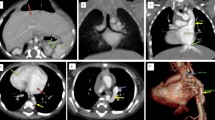Abstract
We report magnetic resonance imaging (MRI) findings of a very unusual venous anomaly case. A 5-year-old boy who had surgical repair of coarctation of the thoracic aorta was referred to our department for evaluation of an enlarged venous structure anterior to the aorta, which had been noted during the surgery. Contrast enhanced dynamic MRI revealed partial anomalous pulmonary venous return to the left azygos vein, double inferior and superior vena cava with the left azygos continuation of the left superior vena cava. The recognition of venous anomalies allows correct planning of surgical and interventional procedures. MRI is a valuable imaging tool providing detailed anatomical information.






Similar content being viewed by others
References
Allen HD, Gutgesell HP, Clark HB et al (2001) Moss and Adams’ heart disease in infants, children and adolescents, 6th edn. Williams and Wilkins, Baltimore, pp 779–781
Ammash NM, Seward JB, Warnes CA et al (1997) Partial anomalous pulmonary venous connection: diagnosis by transesophageal echocardiography. J Am Coll Cardiol 29:1351–1358
Balci NC, Yalcin Y, Tunaci A et al (2003) Assessment of the anomalous pulmonary circulation by dynamic contrast-enhanced MR angiography in under four seconds. Magn Reson Imaging 21:1–7
Chuang VP, Mena CE, Hoskins PA (1974) Congenital anomalies of the inferior vena cava. Review of embryogenesis and presentation of a simplified classification. Br J Radiol 47:206–213
Henle J (1876) Handbuch der systematischen Anatomie des Menschen Dritter Band, Erste Abtheilung. Braunschweig, Vieweg u.S., pp 401
Kimball TR, Witt SA, Pisters EM et al (1994) Coarctation of the aorta and partial anomalous pulmonary venous return: a unique anatomic and physiologic presentation as seen by echocardiography. J Am Soc Echocardiogr 7(2):190–193
Mathews R, Smith PA, Fishman EK et al (1999) Anomalies of the inferior vena cava and renal veins: embryologic and surgical considerations. Urology 53(5):873–880
Minniti S, Visentini S, Procacci C (2002) Congenital anomalies of the venae cavae: embryological origin, imaging features and report of three new variants. Eur Radiol 12(8):2040–55
Moore KL, Persaud TVN (1998) The developing human: clinically oriented embryology, 6th ed. Philadelphia, Saunders pp 352–355
Moreno-Cabral RJ, Reitz BA, Shumway NE (1981) Simultaneous correction of aortic coarctation and partial anomalous pulmonary venous return. Ann Thorac Surg 32(2):197–201
Nandy K, Blair CB (1965) Double superior venae cavae with completely paired azygos veins. Anat Rec 151:1–10
Sakamoto H, Akita K, Sato K et al (1993) Left superior vena cava continuing to the accessory hemiazygos without anastomosis with the coronary sinus. Surg Radiol Anat 15:151–154
Schummer W, Schummer C, Fröber R (2003) Persistent left superior vena cava and central venous catheter position: clinical impact illustrated by four cases. Surg Radiol Anat 25:315–321
Surucu HS, Erbil KM, Tastan C et al (2001) Anomalous veins of the retroperitoneum. Surg Radiol Anat 23:443–445
Takenoshita H (1986) Persistent left superior vena cava with paired azygos veins: report of a case and an attempt at a new classification (in Japanese with English abstract). Kaibogaku Zasshi 61:669–682
Toyoshima M, Sato A, Fukumoto Y et al (1992) Partial anomalous pulmonary venous return showing anomalous venous return to the azygos vein. Intern Med 31:1112–1116
Van Tellingen C, Verzijlbergen F, Plokker HW (1984) A patient with bilateral superior and inferior caval veins. Int J Cardiol 5:366–373
Williams PL (1995) Embryology and development Gray’s anatomy: the anatomical basis of medicine and surgery, 38th ed. New York, Churchill Livingstone, pp 324
Author information
Authors and Affiliations
Corresponding author
Rights and permissions
About this article
Cite this article
Hazirolan, T., Ozkan, E., Haliloglu, M. et al. Complex venous anomalies: magnetic resonance imaging findings in a 5-year-old boy. Surg Radiol Anat 28, 534–538 (2006). https://doi.org/10.1007/s00276-006-0125-9
Received:
Accepted:
Published:
Issue Date:
DOI: https://doi.org/10.1007/s00276-006-0125-9




